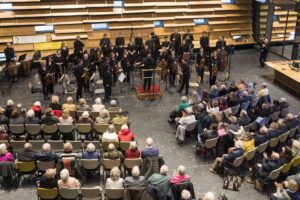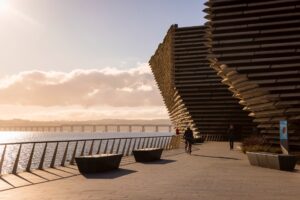People Power: The Impact of Health and Wellbeing Engagement
By organising in-person events and engagement activities, museums and galleries can have a positive impact on the health and wellbeing of their communities. Peter Nurick, Communities Producer at V&A Dundee, shares how they have delivered several large-scale partnership events that complement, expand, and amplify the museum’s vibrant public engagement programmes.

The project
At the start of the pandemic, museums had to adapt rapidly to new ways of working. However, there was no such sudden shift as museums re-emerged – many changed forever – post-pandemic with communities and their cultural counterparts beginning to recover at differing speeds.
At V&A Dundee, much of the work over the last year has been to test and evaluate new ways of working, and gradually re-engage with communities most adversely impacted by COVID-19 in ways that suited them.
With generous support from the players of People’s Postcode Lottery, there has been a steady move to reintroduce more physical engagement to support health and wellbeing, both sides balancing caution with an eagerness to reconnect.
As communities gradually rebounded from the pandemic, larger in-person events gained a new significance. At V&A Dundee, dementia cafés, musical events, a care home day out, and a cancer support conference have allowed us to use the museum in new ways, creating a busy civic space that placed a renewed focus on health and wellbeing for marginalised and isolated communities.
“Such a fabulous event, enabling my mother and I to enjoy quality time together, with fabulous music in a beautiful space.”
Event attendee
Successes
- Since starting in September 2022, our dementia cafés in partnership with Alzheimer Scotland have gone from strength to strength. The first café welcomed 18 people and, just over a year later, attendance is now regularly around 50. This is a mixture of regular visitors and new faces, demonstrating the positive impact that peer support in a beautiful setting can have. For every repeat visit, the impact increases: and as the numbers grow, it solidifies the monthly dementia café as part of V&A Dundee’s regular programme.
- In February, V&A Dundee hosted a dementia-friendly concert in collaboration with the Royal Scottish National Orchestra (RSNO) that provided an uplifting experience for people living with dementia, their friends, families, and carers. Hosting it on a day the museum was already closed to the public ensured we could provide a tailored environment for attendees whilst minimising operational challenges. To ensure the event was dementia friendly, we worked closely with both the RSNO and Alzheimer Scotland. Additional time was allowed for guests to arrive before the performance and hep themselves to refreshments. The naturally-lit ground floor hall minimised the need for artificial lighting and allowed level access from the museum entrance. Quiet break-out areas and a trained dementia dog supported guests throughout.
- In September, the museum held a Big Care Home Day Out for groups of residents and staff from care homes across Dundee. A collaboration with Scottish Care and every one of Dundee’s care homes saw around 180 people enjoy a series of activities delivered by multiple event partners, all inspired by the museum’s current exhibition. Two months later, V&A Dundee hosted CanDu’s (Cancer Dundee) annual conference to explore the role of design in defining and sharing lived experience. Both events helped attract new audiences and used the museum in creative ways to address and explore very different health inequalities.
Challenges
- While we and many other museums were able to weather the storm of the pandemic largely unaltered, many third sector and grassroots community organisations had to radically alter their priorities, staffing was scaled back, and client numbers reduced dramatically. Therefore, the community support network that the museum utilises needed time to heal. Being aware of the priorities beyond the museum’s walls was essential in ensuring we worked at the pace of our most vulnerable communities.
- Large-scale events take longer to plan and – given the additional resources and already stretched capacity – take time to secure whole-museum approval. Planning ahead, involving the wider team and setting expectations from the outset are all critical.

Impact
- With over half of all attendees never having visited V&A Dundee before, the social impact has been huge. Feedback – both written and anecdotal – shows that people see the museum as a safe, welcoming, and social community space. These large-scale events have been fully booked, with the dementia cafe continuing to grow. This qualitive feedback alone shows a huge appetite for these events that would have been unthinkable just twelve months prior.
- The knock-on impact from these major events led to an increase in bookings for tours, workshops, and outreach activities, leading to longer-term but smaller scale – and therefore, more sustainable – engagement. This was clearly seen following the care home event, with many contacting the museum after the event to organise follow-up visits for residents who were unable to make it on the day.
- Feedback from the dementia-friendly concert mentioned it was “accessible, inspiring and confidence-building” and “a safe space to enjoy wonderful music”, while another small group said “The memories rekindled by the wonderful music and the pleasure gained was a joy to see. It was pure delight to be there”, all alluding to the social and cognitive benefit the event had. An unexpected outcome was that it inspired a local dementia choir to use the museum for a one-off performance for their 10th anniversary later in the year.
- Similar feedback followed the Big Care Home Day Out, from staff as well as residents. Staff commented “I felt the day flowed. With the responsibility of looking after the residents, it can be stressful but that was not the case today.”, while another mentioned they were “extremely surprised at the variety of things for residents to enjoy” and they felt “emotionally charged, seeing the reactions of the residents…”.
- Engaging with large and changing audiences can make it difficult to measure long-term improvements to the health and wellbeing of individuals. We focus instead on gathering large amounts of data across our programming. By asking the same evaluation questions across several events, we’re able to collate and compare the feedback we receive.
- The press and social media coverage following these events has raised awareness more broadly, challenging and changing perceptions of what a 21st century museum can and should be.
Guidance
- Larger events can be easier to evaluate than smaller ones due to the longer lead-in times, so greater consideration of evaluation methods can be factored in. The questions asked were discussed with stakeholders to ensure the data gathered was useful to all partners, avoiding multiple evaluation forms.
- On arrival, attendees were given evaluation forms with housekeeping information on the reverse. This not only helped people keep the evaluation form on their person, but also made sure everyone had the event information, given it was more challenging to do a single welcome briefing for multiple small groups all arriving at slightly different times.
- Testing different evaluation methods and seeing the increased uptake (and resulting data it provides) has made us reconsider evaluation methods across all activity types, and we are in the process of organising staff training to improve how we capture information to demonstrate social impact.
- Wristbands can be bought very cheaply and – when given out on arrival – help with group management, guest identification, and quantitative evaluation. They also add a sense of professionalism and uniqueness to the event for attendees.
Evaluation form example
V&A Dundee shared the evaluation below as part of their Big Day Out for care home residents. It was printed on the reverse of an event information sheet that was handed to all attendees.
We really hope you have enjoyed your time at the museum today and that the event has had a positive impact on care homes across the city.
To help us evaluate the event, and learn how we can improve, we would be grateful if you could take the time to answer the following questions.
- Have you visited V&A Dundee before?
- Were you looking forward to your visit today and why?
- How did you feel during your visit today?
- What was your favourite part of the day?
- Was there anything we could have improved or done differently?
Finally, please circle the symbol that sums up your overall feelings from the day.
🙂 😐 🙁
If you have anything else you want to add, please comment below.
Thank you for taking the time to complete this short form – please hand back to a member of staff before you leave. Thanks for coming and we hope to be able to welcome you back to V&A Dundee in the future!
Additional information
Email: Peter Nurick, Communities Producer at V&A Dundee
Visit: V&A Dundee website
Visit: Alzheimer Scotland website